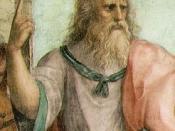Plato's Tomb
EAGLE! Why soarest thou above that tomb?
To what sublime and star-ypaven home
Floatest thou? -
I am the image of swift Plato's spirit,
Ascending heaven; Athens doth inherit
His corpse below.
P. B. Shelley. (1)
Plato's Phaedo is a work that stands proud amongst the great works of Greek literature. The serenity of Socrates as he spends his last few hours before he drinks the hemlock is admirable. The theme of friendship is deeply moving. Even the admiration of the jailor for Socrates beautifully illustrates, what is, a moving and extremely touching work. (2) That it is a wonderful piece of pure literature is beyond doubt, yet it also contains a wealth of philosophical material. The central theme in the Phaedo is the immortality of the soul. Subordinate to this claim yet ubiquitous throughout the text is Plato's theory of Forms and it is in this dialogue that they are given their first formulisation.
The enquiry of Socrates and his interlocutors in Plato's early dialogues (especially Charmides, Laches, Euthyphro and Hippias Major) into the nature of essences are further developed in this dialogue and it is these very developments that will be discussed in this paper. In analysing the developments of Plato's theory of Forms it is essential to determine what views Plato is committed to, and from that, what reading it is possible to take - the 'traditional' or 'transcendent idealist'.(3) The 'traditional' reading of Plato's forms put the emphasis on its metaphysical claims rather than epistemological. The 'transcendent idealist' reading on the other hand stresses that the opposite is the case - the theory of Forms is a theory about knowledge, and, as a side effect, also has metaphysical claims. In dealing with these issues it shall become clear that a definite conclusion cannot be...


